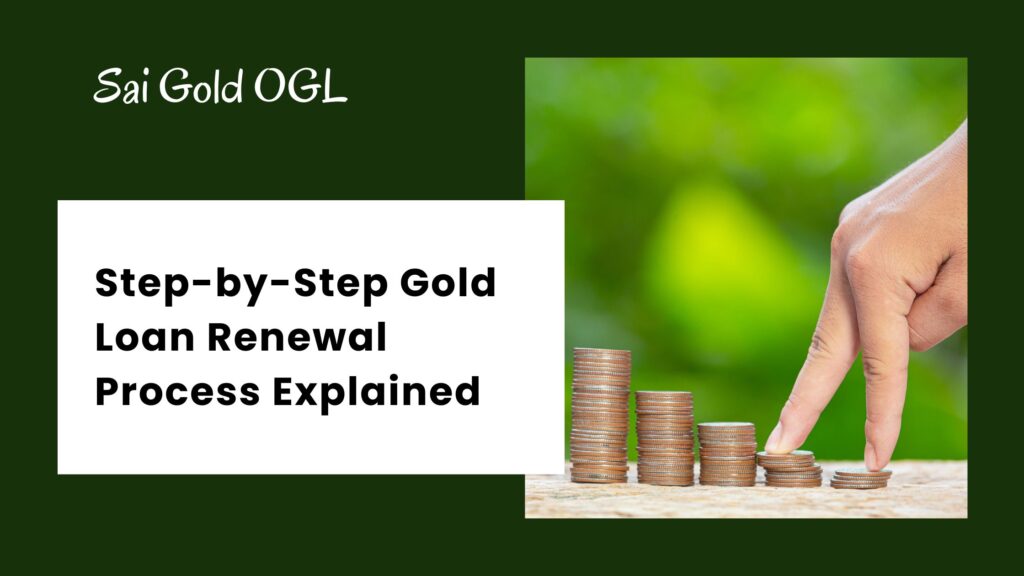Gold loan renewal process has become an important part of using gold loans, which are one of the most convenient, quick, and hassle-free financing options in India. Individuals choose them for emergency needs, education expenses, medical requirements, and even for business use. Since they are secured loans backed by gold ornaments or coins, lenders offer attractive interest rates and flexible tenure.
However, once the loan tenure nears completion, borrowers need to renew the gold loan if they wish to continue using the credit facility without releasing the pledged gold. Gold loan renewal is a simple process, yet many borrowers are unaware of the exact steps, documents needed, or the impact of renewal on interest and principal.
This guide provides a clear, step-by-step explanation of the gold loan renewal process, its benefits, eligibility, and important tips to ensure a smooth and cost-effective experience.
What is Gold Loan Renewal?
Gold loan renewal is the process of extending your existing gold loan after its tenure ends. Instead of closing the loan and retrieving your gold, you renew the loan agreement for an additional tenure. The lender re-evaluates the gold, updates the loan terms if required, and issues a fresh loan agreement.
Renewal helps borrowers continue accessing funds without going through the entire loan application process again.
Why Do Borrowers Renew Gold Loans?
Some common reasons include:
- Need for more time to repay the loan.
- Desire to continue using the borrowing facility.
- Wanting to take advantage of better interest rates or updated policies.
- Cash flow constraints preventing immediate closure of the loan.
- Convenience and speed of getting additional tenure without repledging gold.
Step-by-Step Gold Loan Renewal Process
Below is a simplified and detailed explanation of each step involved in renewing your gold loan.
Step 1: Check Your Gold Loan Tenure and Due Date
The first step is to track the loan maturity date. Lenders usually notify borrowers through SMS, email, or app notifications when the tenure is about to end.
Gold loans generally have a tenure ranging between 3 months to 24 months, depending on the lender. Renewal must be initiated before the due date to avoid penalty charges or auction risks.
Step 2: Visit the Lender’s Branch or Use Online Renewal (if available)
Most banks and NBFCs allow renewal only through their branch, as the gold must be physically inspected. Some lenders, however, offer partial online renewal, especially when only interest payments are due.
Options include:
- Branch Visit: Mandatory for revaluation of gold.
- Online Renewal: Possible if lender permits renewal after paying due interest online.
- Mobile App: Some lenders allow booking an appointment or completing part of the process digitally.
Step 3: Submit Your Loan Account Details
At the branch, the borrower needs to provide:
- Gold loan account number
- A valid ID proof
- Any pending dues (interest or principal)
The loan officer retrieves your loan file, verifies pending amounts, and confirms your eligibility for renewal.
Step 4: Payment of Outstanding Dues
Before renewal, lenders usually require borrowers to clear:
- Overdue interest
- Penal charges (if any)
- Part of the principal (in certain cases)
Making these payments ensures a clean slate for the fresh agreement.
Some NBFCs allow renewal even without principal repayment, while others may ask for a minimum repayment amount depending on the gold’s current value.
Step 5: Gold Revaluation by the Lender
Your gold is evaluated again based on:
- Current market gold prices
- Purity of gold ornaments
- Weight of the gold pledged
Since gold prices fluctuate, revaluation ensures the loan-to-value ratio (LTV) stays compliant with RBI guidelines.
If the gold value has increased, you may be eligible for:
- Higher loan amount
- Top-up loan facility
If the value has decreased, renewal may require additional conditions or partial payment of the principal.
Step 6: Review of Revised Terms and Conditions
After evaluation, the lender proposes fresh terms such as:
- New loan tenure
- Updated interest rate
- Revised loan amount
- Processing fees, if any
Borrowers should carefully go through the terms before signing.
Step 7: Signing the New Gold Loan Agreement
Once all details are finalized, you will:
- Sign the new loan agreement
- Receive an updated repayment schedule
- Get confirmation of renewal through SMS or email
This marks the official renewal of your gold loan.
Step 8: Issuance of Fresh Loan Certificate or Statement
After renewal, the lender provides:
- Updated loan account number (if applicable)
- New loan certificate
- Revised loan passbook or statement
The gold remains safely stored with the lender until final repayment or further renewal.
Important Points before Gold Loan Renewal Process
1. Check Interest Rates
Interest rates may change at renewal, so compare with other lenders before renewing.
2. Verify the LTV Ratio
If your loan amount is too high compared to gold value, renewal may require partial repayment.
3. Understand Penalty Clauses
Late or overdue payments may attract penalties that should be cleared before renewal.
4. Keep Track of Gold Prices
High prices during renewal can benefit you with a higher eligible amount.
5. Ask About Processing Fees
Some lenders charge nominal fees at renewal; verify beforehand.
FAQs About Gold Loan Renewal Process
Some lenders allow partial online renewal if interest payments are done digitally. However, a branch visit is usually required for physical revaluation of gold.
If the loan is not renewed or repaid by the due date, the lender may: Charge penalties, Mark the account as overdue, Start auction proceedings after multiple reminders, Timely renewal prevents such issues.
Most lenders only require payment of pending interest, but some may ask for partial repayment depending on gold value and LTV ratio.
Yes. Lenders revise interest rates based on market conditions and their internal policies. It might increase or decrease.
Yes, if the gold’s market value has risen or if your lender’s LTV allows, you may qualify for an additional top-up loan.







